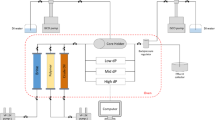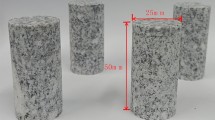The low permeability conglomerate reservoir in Mahu sag has huge resource potential. However, due to the large distribution of fine throats and complex pore seepage system, Mahu tight glutenite reservoir is characterized by large production difference of single well, high oil and gas decline rate and low recovery factor. In this paper, the microstructure and composition characteristics of Mahu conglomerate are studied by means of NMR, Water sensitive injury experiment was carried out. The results show that the strong heterogeneity of the reservoir in Mahu Baikouquan formation seriously affects the physical property characteristics and pore throat development characteristics. The strong heterogeneity leads to the uneven advance of water drive front, and the highest recovery factor is 30%. With the increase of the number of soak back flow, the fracture closed unevenly, resulting in the low flowback rate of soaking well after fracturing. The higher the proppant concentration is, the stronger the conductivity is. Compared with carbon dioxide, natural gas and deoxidized air, the oil displacement efficiency of carbon dioxide is the highest (70–85%), followed by natural gas (55%). In the aspect of research on the law of cross permeability between fractures and matrix, the natural energy release and exploitation of conglomerate reservoir is carried out. The recovery factor is relatively low, but after natural gas flooding, the core matrix will supply oil to the fractures in the process of backflow, which eventually makes the oil saturation in the matrix decrease significantly, and the degree of crude oil production increases. The matrix in the middle of the fracture is the main residual oil enrichment area. It is of great significance to improve the recovery rate of conglomerate.





Similar content being viewed by others
References
Chaohe Fang. Zhilong Huang, Qiaozhi Wang et al., “Cause and significance of the ultralow water saturation in gas-enriched shale reservoir,” Natural Gas Geoscience, 235, No.3.471-476(2014)
Jun Yao, Hai Sun, Dongyan Fan et al, “Delivery mechanism and numerical simulation of shale gas reservoir”, Journal of China University of Petroleum (Natural Science Edition), 37, No. 1, 91-98 (2013).
Caineng Zou, Jianzhong Li, Dazhong Dong et al., “China’s first discovery of rich nano-scaled pores in shale gas reservoir,” Petroleum Exploration and Development, 37, No. 5, 508-509 (2010).
Y. L. Jiang, H. Q. Xue, H. Y. Wang et al., “The measurement of shale gas content,” Applied Mechanics and Materials, 288, 333-337 (2013).
Honglin Liu, Hongyan Wang, and Jianbo Zhang, “Calculation of CBM Adsorption Time and Analysis of its Influencing Factors,” Petroleum Geology and Experiment, 22, No. 4 (2000).
Yuxi Li, Dewu Qiao, Wenli Jiang et al. “Summary for gas content and geological evaluation of shale gas,” Geological Bulletin of China, 30, No. 2, 308-317 (2011).
S. L. Montgomery, D. M. Jarvie, K. A. Bowker et al., “Mississippian Barnett Shale, Fort Worth basin, north-central Texas: Gas-shale play with multi–trillion cubic foot potential,” AAPG Bulletin, 89, No. 2, 155-175 (2005).
K. A. Bowker, “Barnett Shale gas production, Fort Worth Basin: Issues and discussion,” AAPG Bulletin, 91, No. 4, 523-533 (2007).
Kai Qian and Qingbo Zhao, in: Exploration & Development Theory and Experimental Testing Technology of Coalbed Methane. Petroleum Industry Press, Beijing (1996), pp. 143-148.
Yuxi Li, Dewu Qiao, Wenli Jiang et al., “Summary for gas content and geological evaluation of shale gas,” Geological Bulletin of China, 30, No. 2, 308-317 (2011).
Ying Tang, Jinchuan Zhang, Zhujiang Liu et al., “Measurement of shale gas content with desorption method and improvement of its method,” Natural Gas Industry, 31, No. 10, 108-112 (2011).
Zhiping Li and Zhifeng Li, “Seepage dynamic characteristics of shale gas nano-scaled pores,” Natural Gas Industry, 32, No. 4, 50-53 (2010).
Yang L., Ge H., Shi X. et al. “The effect of microstructure and rock mineralogy on water imbibition characteristics in tight reservoirs,” Journal of Natural Gas and Science and Engineering. 34, No.2, 1461-1471 (2016).
Author information
Authors and Affiliations
Corresponding author
Additional information
Translated from Khimiya i Tekhnologiya Topliv i Masel, No. 5, pp. 83–86 September–October, 2022.
Rights and permissions
Springer Nature or its licensor (e.g. a society or other partner) holds exclusive rights to this article under a publishing agreement with the author(s) or other rightsholder(s); author self-archiving of the accepted manuscript version of this article is solely governed by the terms of such publishing agreement and applicable law.
About this article
Cite this article
Zhu, Y., Shi, Y., Yang, B. et al. Permeability Characteristics and Influencing Factors of Fracturing Fluid in Glutenite Reservoir Based on NMR. Chem Technol Fuels Oils 58, 815–819 (2022). https://doi.org/10.1007/s10553-022-01455-8
Published:
Issue Date:
DOI: https://doi.org/10.1007/s10553-022-01455-8




